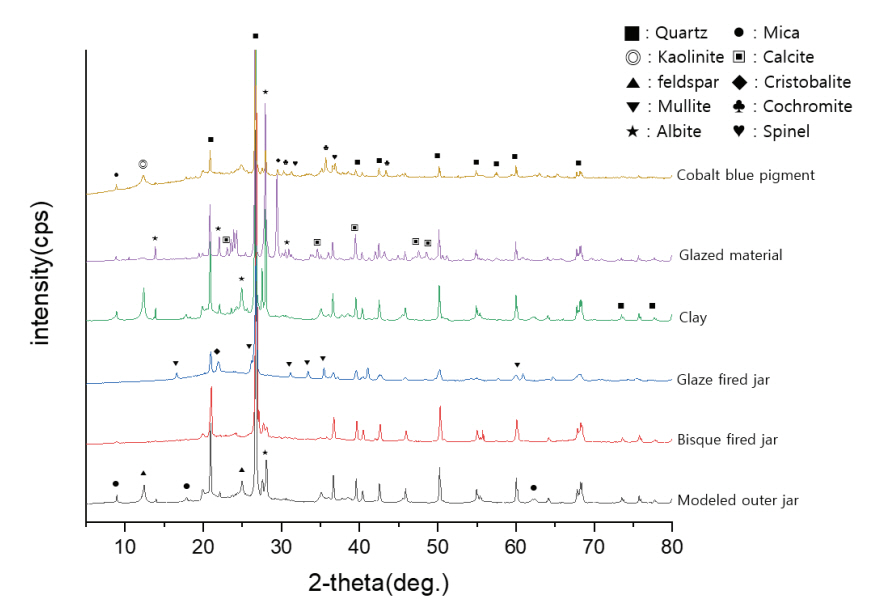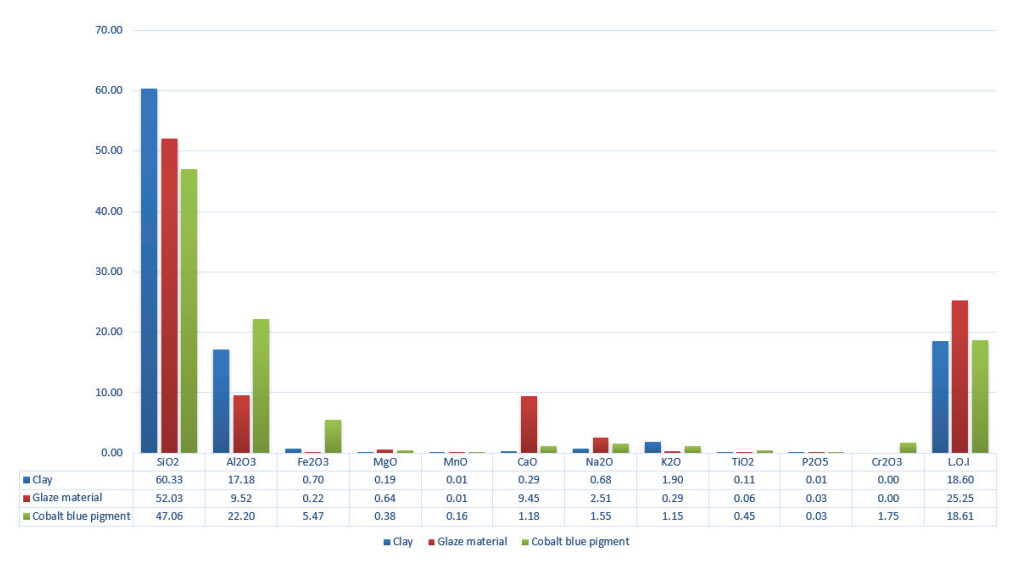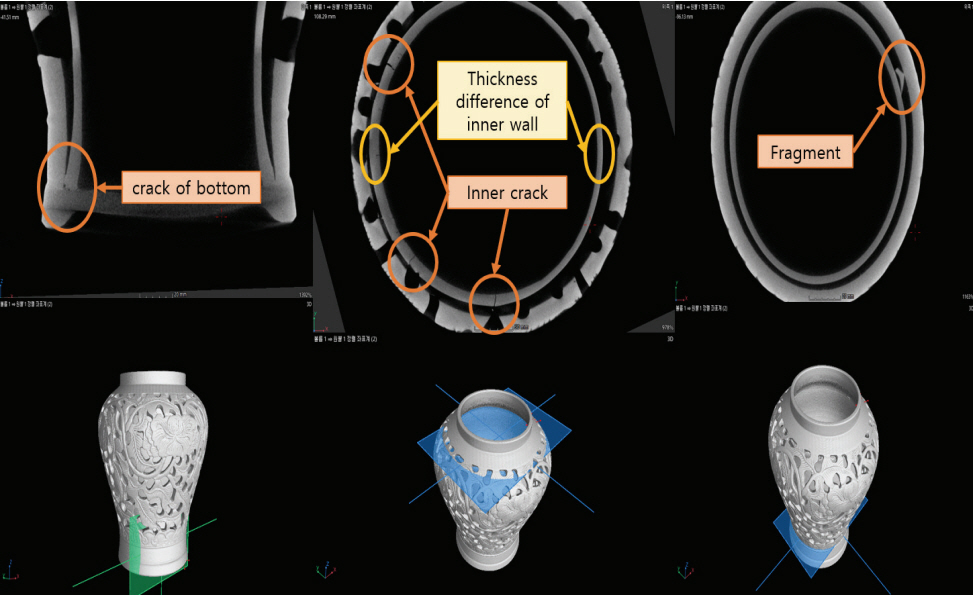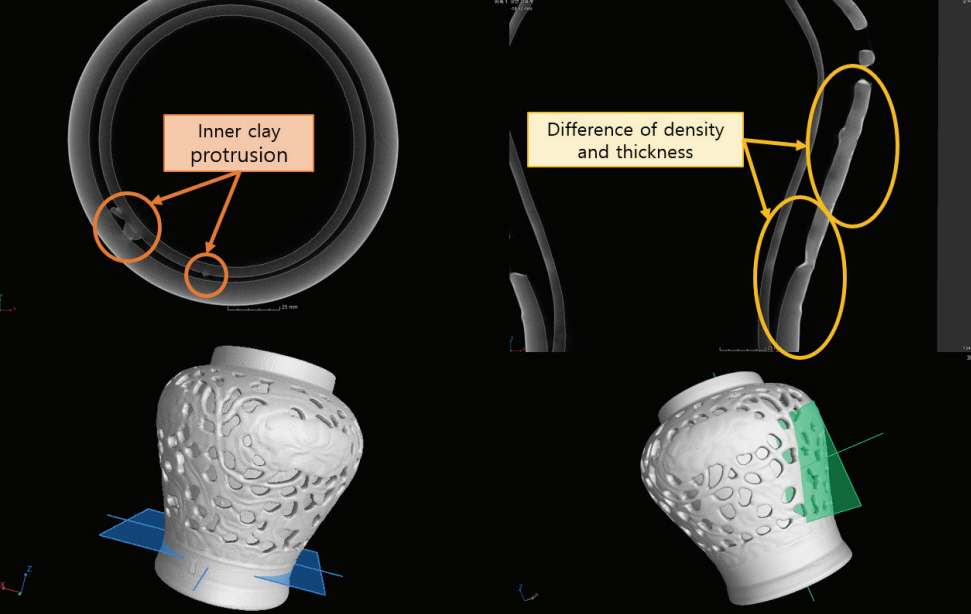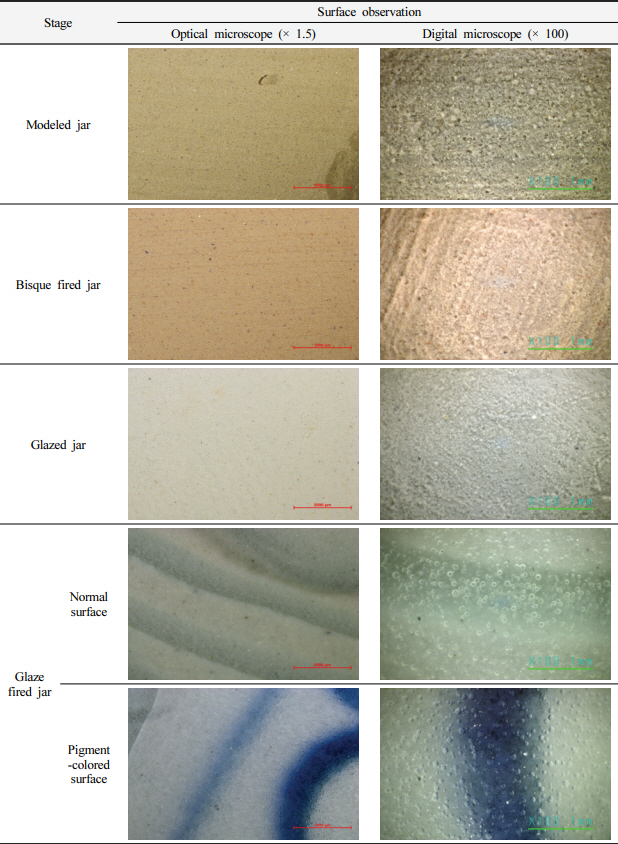1. INTRODUCTION
With the development of mankind, the manufacturing of containers using clay has continued, and its development further repeated with the development of firing technology. Among them, porcelain refers to all objects fired after making with clay and is used in a broad sense to refer to all of earthenware, pottery, and porcelain (Kang, 2012). Porcelain is made by sufficiently sintering the base material comprised of a mixture of kaolin clay, quartz, feldspar, and pottery stone until it is porcelainized at a high temperature of 1300℃ or higher, and as glaze, feldspar oil, limestone oil, and talc oil are mainly used (Bae, 2019).
Representative porcelain in Korean history includes celadon produced in the Goryeo Dynasty and white porcelain produced in the Joseon Dynasty. The Joseon white porcelain that was made in “Gwanyo,” i.e., royal kiln, in Gwangju, Gyeonggi-do and at the kilns in other regions, is characterized with graceful features an elegant style without exaggeration (Kang, 2012). In particular, the White Porcelain Jar with Openwork Peony and Scroll Design in Underglaze Cobalt Blue, which is estimated to have been produced in a kiln located in Gwangju, Gyeonggi-do in the late 18th century, was made with the openwork technique, and has vine patterns made with Cobalt blue on the shoulder and a flower pattern band on the waist. The outer jar has a curved shape that is typical of common Joseon jars (Cultural Heritage Administration, 2022).
Porcelains made from clay, including white porcelain, undergo two firing, the bisque firing and glaze firing, which change the physical properties of raw materials such as the constituent minerals that make up the clay, density, and absorption rate, and the identification of the change in physical properties of white porcelain according to the manufacturing stage provides important information on porcelain and pottery making techniques and raw material characteristics. Until now, there have been many studies that have examined the characteristics of white porcelain made using traditional methods, but few studies have closely compared the characteristics by dividing it into each process (step-by-step).
In this study, we produced reproductions of white porcelain, blue-and-white openwork peony arabesque pattern jar for each manufacturing stage and intended to research the detailed physical and chemical properties of the reproductions by comparing them with the raw materials used.
2. SUBJECT AND METHODS
2.1. Subject
Manufacturing of the reproduction of the White Porcelain Jar with Openwork Peony and Scroll Design in Underglaze Cobalt Blue used in the study was commissioned to a pottery workshop (Dajeong Pottery) in Icheon-si, Gyeonggi-do, and three types of materials including clay, glaze, and cobalt blue pigment for drawing the patterns were used (Figure 1). We made eight pieces of reproductions in accordance with the manufacturing stages, which include “Modeled jar (outer and inner)”, “Assembled inner and outer jars” of two jars after modeling, “Carved jar” after assembling, “Bisque fired jar (firing temperature about 850∼900℃)” after “Cobalt blue jar” coated with glaze after painting, and “Glaze fired jar (firing temperature about 1250℃)” after coating with glaze (Figure 2).
2.2. Methods
To observe the surface characteristics of the materials used in pottery manufacturing and the reproductions at each manufacturing stage, the surface condition was observed using a portable microscope (DG-3, Scalar, JPN) and a stereoscopic microscope (SMZ800N, Nikon, JPN), and the chromaticity was measured using a portable color difference meter (CM-700d, Minolta, JPN) and then graphed using CIE LAB color space. The machine was set up to use the average value measured three times.
We took a part of the clay and pulverized it to analyze the crystal structure of the constituent minerals using an X-ray diffraction analyzer (Miniflex 600, Rigaku, JPN), under the analysis conditions set to 40 kV, 15 mA, 5°~80°, scan step 0.02°, and scan speed 2°/min.
In addition, we heated the powder sample at 950°C for 3 h to measure the scorching heat loss (L.O.I) and made it into a glass bead to analyze 10 major components and compared material properties using the wavelength-dispersive X-ray Fluorescence Sequential Spectrometer (S8 Tiger Series, Bruker, USA). The analysis was requested to the Daegu Center of the Korea Basic Science Institute.
To compare the physical properties related to the pores of the clay, the apparent porosity ratio, absorption rate, apparent specific gravity, and volumetric specific gravity were measured with reproductions of each manufacturing stage using precision electronic scales (GR-200, A&D, JPN) and specific gravity measuring kit (AD-1653, A&D, JPN). In order to confirm the physical properties of the body, the glaze layer was removed before measuring.
To check the change in the magnetic susceptibility value that appears in the production and firing process of the reproductions, the magnetic susceptibility was measured in interpolation mode using a portable magnetic susceptibility meter (SM-30, ZH Instruments, CZE).
To observe the microhistological characteristics of the cross-section, a mounted specimen was made to confirm the layered configuration with a stereoscopic microscope (M80 Microscope, Leica, DEU), and we observed constituent particles and their states with secondary electron images (secondary electron images) and back scattered electron images of a scanning electronic microscope (SEM, SU3800, Hitachi, JPN).
To nondestructively check the composition and defects of the overall internal cross-section of pottery, Dukin Co., Ltd., on our request, obtained CT images with a Computed Tomography (Bright 240 450 CTR, DI Solution, KOR) under the measurement conditions set to 200 kV and 100 μA. After taking 720 2D X-ray precision images while dividing each reproduction into the top and bottom and rotating 360°, the entire image was materialized as a 3D CT top and bottom combined image using a reconstruction algorithm. Characteristic images extracted were analyzed after capturing with an image viewer program (Volume Graphics VGL).
3. RESULTS
3.1. Color difference
From the color difference, we get to know the characteristics of the materials contained in the raw materials, and the surface color of the reproductions appears differently depending on the chemical composition of the raw material and the firing environment. So, we can compare the burning degree and firing atmosphere based on color information. Ultimately, since the collection of minerals that make up the material is the clay that makes up the pottery, the difference in mineral crystals which appears becomes the core of pottery classification through appearance (Mitri and Davit, 2004).
The measured values were graphed using CIE LAB color spaces represented by a*(red-green) b*(yellow–blue) and L*(brightness) corresponding to KS A 0067 among the methods of displaying colors in the Korean Industrial Standard (KS).
First, the clay and cobalt blue pigments, which are pottery raw materials, were found to have similar brightness (L*) and chroma (a*) values and were not significantly distinguished by color except for slight differences in brightness visually. In the case of glaze, the brightness (L*) was 88.56, which was relatively higher than that of the other two materials, and the color observed visually also showed a clear difference from the other two materials (Figure 3).
When we measured chromaticity of modeled clay sculpture, bisque firing piece, glazed piece, and glazed firing piece based on firing among the reproductions for each of the manufacturing stage, we obtained the same results as those found through visual observation. In the case of the modeled clay sculpture, L* value was 70.99, a* value was 2.49, and b* value was 10.67. But in the case of the bisque firing piece, L* value was 81.95, a* value was 10.43, and b* value was 15.98, which showed increase in both brightness and chroma. The glazed piece showed L* value of 92.88, a* value of 0.03 and b* value of 3.87, which showed decrease in chroma and significant increase in brightness compared to the bisque firing piece. This is believed to result from the chromaticity characteristics of the previously analyzed glaze material applied on the surface of bisque firing piece. The glaze firing piece had the L* value of 75.00, a* value of –3.66 and b* value of 2.56, where both brightness and chroma decreased compared to the bisque firing piece and glazed piece (Table 1).
The distinguishing characteristics of color difference in raw materials and reproductions are that the red and yellow chromaticity of the bisque firing primary piece are higher than those of modeled pieces made of raw materials. We could see that the red and yellow chromaticity of the glaze firing piece decreased drastically compared to all materials, and the brightness showed relatively little change.
3.2. Constituent minerals
We applied the X-ray diffraction analysis method to find out the changes in the raw materials of white porcelain and the constituent minerals of reproductions of each manufacturing stage and compared the characteristics. This method began in the early 1970s as a technique of identifying minerals in various potteries made of clay and estimating the firing temperature (Moon and Lee, 1996).
In the process of making white porcelain, the crystal structure of the internal clay changes through the two firing. The most typically identified changes in crystal structure are the phase transition of quartz occurring around 573℃, mullite generating around 1050℃, and cristobalite generating at 1250℃ or higher. Mullite and cristobalite, due to their generating temperature, can be used as high temperature– indicative minerals to infer the firing temperature of pottery.
As a method for identifying these indicative minerals, a crystal structure analysis method using an X-ray diffraction analysis is the most representative. Through this, it is possible to estimate the firing temperature by indirectly analyzing the crystal generation and change of the temperature-indicative mineral present therein. In addition, the characteristics of each specimen can be compared and analyzed based on the analysis results and used for estimating their provenance of production (Han, 2006).
As a result of X-ray diffraction analysis for analyzing the constituent minerals of clay, glaze, and cobalt blue pigments, which are reproduction raw materials, quartz and mica were commonly identified in all materials. In glaze with high content of limestone, calcite and albite of plagioclase group were identified, and in the cobalt blue pigment, spinel was identified. In particular, Cochromite, a cobalt chromium oxide, was identified only in cobalt blue pigment, which is estimated to be a major factor of blue color development. As a result of analyzing the constituent minerals of the reproductions by manufacturing stage, quartz, mica, albite, and kaolinite were identified in the modeled jar, and in the bisque firing piece, the kaolinite, which was identified in the modeled jar, disappeared, and the peak intensity of quartz, mica, and albite was reduced. In the glaze fired jar, low-temperature minerals disappeared and high temperature– indicative minerals, mullite and cristobalite, were identified.
In conclusion, we can see that mica and illite existing in the making raw materials continue to exist until the bisque firing stage, but in the glaze firing piece at a high temperature, these two minerals disappear, and the high-temperature minerals, mullite and cristobalite, are generated (Table 2, Figure 4).
3.3. Major components
As a result of analyzing 10 constituents to see the basic characteristics of the reproduction constituents, the high content of silica (SiO2) and alumina (Al2O3) were identified in all materials, indicating that former material (acidic oxide: RO2) and plastic material (neutral oxide: R2O3) accounted for most of reproduction raw materials (Table 3). In the case of clay, silica (SiO2) content was found to be the highest, and the glaze was confirmed to have a relatively high content of calcium oxide compared to other materials. The cobalt blue pigment has a relatively higher content of iron oxide (Fe2O3) than the other two materials, and chromium oxide (Cr2O3) has been uniquely identified in it, which was estimated to be a major factor in the blue color development. It shows the similarity to chromium cobalt oxide confirmed in the Cobalt blue pigment in the previous analysis of the constituent minerals. In addition, we can see that clay and glaze have similar basic composition ratio (Figure 5).
3.4. Magnetic susceptibility of reproductions
In order to confirm the change in the degree of magnetization by step of the reproduction, magnetic susceptibility was measured.
As a result of measuring the changes in the magnetic susceptibility of white porcelain reproduction by manufacturing stage, the average in the modeling stage was about −0.0418 and the standard deviation was about 0.0181, in the bisque firing stage, the average was about 0.0294 and the standard deviation was about 0.0306, in the glazing stage the average was about 0.0250 and the standard deviation was about 0.0418, and in the glaze firing stage, the average was about −0.0482 and the standard deviation was about 0.0534 (10-3 Sl unit). And in all of the reproductions in four stages which are targets of measurement, magnetic susceptibility showed an increasing tendency when moving from the top of the object to the middle, and a decreasing tendency when moving from the middle to the bottom.
As a result of confirming the overall distribution, the distribution value of the magnetic susceptibility was lowered in the order of the bisque fired jar and glazed jar, modeled jar, and glaze fired jar. The magnetic susceptibility value was almost the same in the bisque firing piece and glazed piece. Therefore, as is generally known, experiments show that the magnetic material contained in clay, which is a raw material for manufacturing pottery, is set to zero during the firing, causing a decrease in the magnetic susceptibility value (Figure 6).
3.5. Apparent porosity, absorption rate, and specific gravity of reproductions
We measured the apparent porosity, absorption rate, and specific gravity of the bisque firing pieces and the glaze firing piece among the pottery reproductions by manufacturing stage, and to clearly compare only the clay characteristics, the glaze layer was removed before measuring in case of the glaze firing piece. As a result of the measurement, it was confirmed that the apparent specific gravity was 2.61 for the bisque fired jar and 2.16 for the glaze fired jar, namely that for the glaze fired jar was relatively lower. In the case of the volumetric specific gravity, that of the glaze fired jar was 2.14, relatively higher than that of the bisque fired jar, which was 1.71, unlike the apparent specific gravity. In the case of the absorption rate, 20.2% for the bisque fired jar and 0.562% for the glaze firing piece were confirmed, and the apparent porosity was 34.6% for the bisque fired jar and 1.2% for glaze fired jar. Both the absorption rate and the apparent porosity were very low in the glaze firing piece compared to the bisque fired jar. In conclusion, we can see that the pores disappeared as the inside and outside of the clay were vitrified. However, the small change in specific gravity suggests that there are still many closed pores trapped inside (Figure 7).
3.6. Surface properties of reproductions
When we observed the surface of the reproduction by manufacturing stage of the white porcelain, the matrix of the clay was fine and uniform regardless of the manufacturing stage, and the mineral particles were fine. This seems to be due to the process called levigation, a method of purifying clay by sedimentation, by which only clay below a certain particle size is selected before being used. In addition, in the case of modeled jars and bisque fired jars, traces of the use of a spinning wheel were observed during the manufacturing stage.
The detailed features are as follows. First, compared to the modeled jar, the color of the clay changed from dark brown to light ocher, and the particle size of the mineral was very fine like the modeled jar. The glazed jar had a white color overall. The matrix was fine and uniform like clay, and the mineral particle was very fine. In the case of the glaze fired jar, a good number of pores were observed as a whole, and the color of the clay changed from ocher to white compared to the bisque fired jar. In the base layer jade green and blue patterns were observed. Vitrification occurred because of the high temperature environment, which increased luster and transparency (Table 4).
3.7. Characteristics of reproduction’s cross-sectional texture
Through cross-sectional observation of pottery using an optical microscope or an electron microscope, it is possible to check the pores or bubbles formed in the firing process to be present in the clay and glaze and the crystal size and distribution condition of constituent minerals and to observe the generated crystals and their states.
Therefore, when we observed the cross sections of the pottery reproductions of bisque fired jar and glaze fired jar by manufacturing stage, the bisque fired jar were apricot-colored overall and orange or red particles were observed here and there, and in the case of glaze fired jars, the clay was white, and a few black particles were observed here and there. The color seen in the bisque fired jar results from the phase of the mineral generated in the oxidizing environment of the clay material, and it is estimated that it was mainly affected by the iron (Fe) component. On the other hand, in the case of the glaze firing piece, the clay color changes to white and some black particles are observed as the reduction atmosphere of a high temperature is formed. As a result of analyzing them, iron (Fe) and a minor amount of titanium (Ti) were detected. Therefore, they are presumed to be ilmenite (FeTiO3) or iron oxide, which are frequently reported in celadons (Han and Lee, 2020).
The degree of vitrification progress can be identified based on the shape and size of the pores, which are part of the microstructural characteristics. From the fact that there are no large or irregular-shaped particles in the bisque fired and glaze fired jars, we can see that very fine-grain and selected raw materials were used. In the bisque fired jar, there is difference in density between the glaze layer and the clay layer, but there are many irregular pores and air bubbles. On the other hand, in the case of glaze fired jar, the particle nature of the clay was found to be lower than that of the bisque fired jar, which was caused by vitrification of the clay particles through the glaze firing at a higher temperature. In addition, we can see that the glaze layer has little air bubbles in the glassy layer that is completely melted compared to the clay layer and can confirm that some air bubbles that could not escape to the outside gathered to form large air bubbles. What is unusual is that bubbles or new mineral crystals were not identified between the glaze layer expressed in blue and the transparent glaze layer in the stereoscopic microscope. We presume this is because the blue pigment was painted on the glaze layer, and the blue pigment penetrating into the glaze layer was almost completely dispersed and distributed to manifest as a color (Table 5).
3.8. Image analysis of reproductions
We performed CT image photography on the bisque fired jars and the glaze fired jars out of the pottery reproductions for each manufacturing stage according to the firing and using the image viewer program we could observe the defects inside the reproductions that were difficult to visually identify. In the image analysis, we found cracks at the bottom of the object or at the area where the outside and the inside were combined. And fragments that had got into the object during the pattern carving process and not been removed were also found at the bottom of it. In addition, we found a number of cracks and wall thickness differences inside the upper end of the bisque fired jar, which indicate that the wall thickness of the object was not properly controlled in the manufacturing stage. In the case of the glaze fired jar, some of the internal clay protruded at the bottom, which may have resulted from expanding and swelling of a specific material or moisture in pores as the firing temperature rose to a high level. In addition, we could nondestructively identify the difference in density and thickness and the change in firing from the outer and inner shapes and the shading of CT images at the middle part (Figure 8,9).
4. DISCUSSION AND CONCLUSTIONS
We produced the reproductions of Korean white porcelain, White Porcelain Jar with Peony and Scroll Design in Underglaze Cobalt Blue, and analyzed the materials used and reproductions at each stage. In addition, we compared and analyzed what physicochemical changes the clay showed in the process and considered its characteristics and their correlation.
First, we observed the surface of the reproductions by the manufacturing stage and measured their chromaticity. Therefore, we confirmed that the clay was of considerably high quality because the clay matrix was fine and uniform regardless of the manufacturing stage, and the mineral particles were fine. Going through the firing, bisque fired jar’s the color of the reproductions by manufacturing stage had increased in red and yellow chromaticity compared to the raw materials, but had drastically decreased in the glaze fired jars. It can be confirmed visually as well as from the chromaticity graph illustrated in the LAB color space. This confirms that the color of the material is important, but the relative quantity of constituent minerals present therein, and the firing atmosphere have a great influence on the chromaticity. Namely, what affects this color is the content and composition ratio of the main constituents along with the firing atmosphere. In the actual component analysis, we see that all materials have high content of silica (SiO2) and alumina (Al2O3), so former materials (acidic oxide: RO2) and plastic materials (neutral oxide: R2O3) account for most of the raw materials of pottery, which affect basic color change. Of course, the content of iron controlling the color development is more important.
Next, the change in constituent minerals and the firing temperature have a characteristic correlation by stage. In the actual analysis of compositional minerals, mica, feldspar, and kaolinite, which were found in the modeled clay sculpture, tended to disappear after their peak height decreased while going through the bisque firing and the glaze firing processes. The high temperature–indicative minerals, both mullite and cristobalite, were not present in the modeled jar but found in the glaze fired jars. Basically, this enables us to estimate that the glaze firing temperature is 1250°C or higher. In other words, we can observe the disappearance and generation of various minerals in reproductions by stage. In addition, we can see that the magnetic susceptibility value changes during the firing. In other words, there was a tendency of the magnetic susceptibility value decreasing in the order of glazed jar and bisque fired jar → modeled jar → glaze fired jar. From making this reproduction by stage, we confirmed that magnetic materials such as iron contained in the clay, a material for making pottery, are set to zero during the firing, causing a lower magnetic susceptibility value.
The most important thing in the change in characteristics at each manufacturing stage is the change in the microstructural characteristics of the cross-section. Although there is a slight difference in density between the glaze layer and the clay layer of the bisque fired jars, in the glaze fired jars the difference is completely distinguished because of vitrification of the glaze layer. Also, there were a large number of irregular pores and air bubbles in the bisque fired jars, but very few were observed in the glaze fired jars. A similar tendency appeared in the specific gravity measurement. It was unusual that the area colored with cobalt blue pigment was not distinguishably observed. We think it was because the inlaid technique was not used, but the coloring technique of applying the pigment on top of the clay using a brush was applied. However, orange or red particles observed here and there on the bisque firing pieces disappeared in the glaze firing pieces, the body was white, and a small number of black particles were observed. The cause is presumed to be FeTiO3 or iron oxide contained in iron (Fe).
Lastly, we checked the physical characteristics of the white porcelain by manufacturing stage nondestructively using CT scan images. Cracks were observed at the bottom of both the bisque fired jars and the glaze fired jar, which were presumed to have occurred at the area where two objects are overlapped considering the nature of the openwork jar into which two jars are combined after made. We also confirmed that we could identify the cracks in the reproduction which were difficult to find with the naked eye and effectively observe the firing state of inner layer body, thickness and density at each point of the reproduction, and the changing looks by production stage.
In conclusion, identifying the physical properties of the initial materials used in pottery making and identifying the changes in physical properties after making reproductions by manufacturing stage could provide useful information in finding out the production technique for actual excavated relics and it could become a basis for easily estimating the information on the materials compared to the actual future excavated cultural properties.







